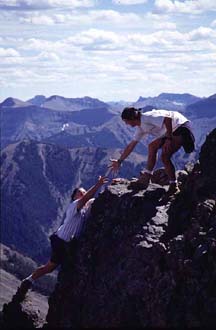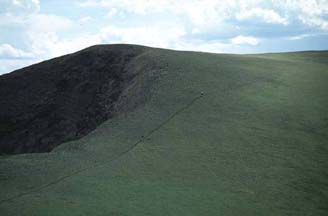


THE YELLOWSTONE BACKCOUNTRY PAGE


Much of Yellowstone is still unexplored and unsurveyed to this day. Numerous hot springs, creeks, lakes, canyons and waterfalls have still never been documented in the park's pristine wilderness.
What is backcountry? For the purposes of this page it is defined as any part of Yellowstone National Park that is over 100 yards from a main paved highway.
I hope you enjoy these pages and that you learn something about the lesser known parts of Yellowstone. If you would like to contribute new information to this page please contact me HERE.
NOTE: I WILL BE IN YELLOWSTONE FROM MEMORIAL DAY THROUGH LABOR DAY. MUCH OF THAT TIME WILL BE SPENT IN THE BACKCOUNTRY GATHERING PHOTOGRAPHS FOR THIS WEBSITE. SO IF YOU DON'T SEE A PHOTO HERE NOW, CHECK BACK IN A FEW MONTHS!!


SOME FACTS ABOUT YELLOWSTONE AND ITS BACKCOUNTRY:
AREA
In size, Yellowstone is the 8th largest park in the United States, 12th in North America, and 50th in the world. (Greenland National Park is the largest National Park in the world and is roughly 77 times the size of Yellowstone)
The park area is exactly 2,221,772.61 acres; or 3471.52 square miles.
Its dimensions are roughly 63 miles north-south by 54 miles east-west.
It is 91.0% in Wyoming; 7.6% in Montana; and 1.4% in Idaho.
CLIMATE
Annual precipitation ranges from 10 inches (26 cm) at the north boundary to 80 inches (205cm) in the southwest corner.
Temperatures (average) range from 9° F in January to 80° F in July at Mammoth Hot Springs.
The Record High Temperature of 98° F was recorded at the Lamar Valley in 1936.
The Record Low Temperature of -66° F was recorded at Madison Jct. in 1933.
PHYSICAL GEOGRAPHY
The topography of Yellowstone is roughly 80% forest, 10% meadows, 9% water and 1% developed areas (roads or buildings).
There are 136 named lakes and hundreds of unnamed small lakes and ponds.
There are 15 named rivers.
There are 241 named creeks, along with hundreds of cataloged and numbered, unnamed creeks.
Hidden up many of these streams are over 300 waterfalls and cascades.
Elevations range from 5,130 feet near Reese Creek, northwest of Gardiner, Montana to 11,358 at the summit of Eagle Peak in the southeast corner.
GEOLOGY
Within Yellowstone’s borders are about two-thirds of the world’s geysers and over half of the world’s thermal features.
The park contains roughly 10,000 thermal features scattered over an area of approximately 1,800 square miles.
More than 100 clusters of hot springs are known to exist containing approximately 200-250 active geysers.
Central Yellowstone houses one of the world's largest calderas, measuring 28 by 47 miles (45 by 75 km).
Its 40 square miles of fossil forests are more extensive than any other in the world.
FLORA
Its forests contain eight species of conifers with approximately 80% of them being lodgepole pine.
There are approximately 1,100 species of native vascular plants.
Also found are 170 species of exotic (non-native) plants and 186 species of lichens.
WILDLIFE
The Yellowstone backcountry is home to the largest concentration of elk anywhere in the world.
It is one of the last remaining strongholds of the grizzly in the lower 48 states.
It is the only place in the United States a where a wild buffalo herd has survived continuously since primitive times. (And one of only two such places in the world)
Yellowstone contains:
![]() 7 species of native ungulates, 2 species of bears and approximately 50 species of other mammals.
7 species of native ungulates, 2 species of bears and approximately 50 species of other mammals.
![]() 311 recorded species of birds. (160 of them are nesting species)
311 recorded species of birds. (160 of them are nesting species)
![]() 18 species of fish. (5 non-native)
18 species of fish. (5 non-native)
![]() 6 species of reptiles.
6 species of reptiles.
![]() 4 species of amphibians.
4 species of amphibians.
TRAIL SYSTEM
There are at least 1,000 miles of backcountry trails, emanating from 97 trailheads.
Along this extensive trail system are 287 backcountry campsites.

THE STATE OF THE PARK 1999
The following is an excerpt from the State of The Park Report for 1999. It contains some fascinating information about what is “out there” in the Yellowstone backcountry. Many of these locations are explained in more detail in the other sections of this website.
More than 1,000 American Indian and EuroAmerican archeological sites have been documented in Yellowstone. Many have not been visited since their initial recording more than 30 years ago. Current conditions are poor and unknown.
NATIVE AMERICANS
Eighty-four percent of recorded archeological sites are of American Indian origin. In addition to their network of trails, the Indians left behind burial sites near fishing bridge, a bison kill along the shore of Yellowstone Lake. Tiny campsites indicated by only a few obsidian chips, rock shelters, teepee rings, and wickiups – tipi-shaped shelters of wood, the remains of which can be discerned in some backcountry sites. Few of these sites have been evaluated as to tribal or cultural affiliation. The archeological evidence suggests that most Indian use during the past 11,000 years occurred seasonally by a variety of groups including the Crow, Shoshone, Bannock, Nez Perce, and Blackfeet.
EUROAMERICAN SITES
Many of the known sites date from the late 1800’s to the mid-1940’s and are associated with early park development under the U. S. Army and the NPS, as well as with the development of concessions within the park.
Recorded sites include:
![]() Queen’s Laundry bathhouse.
Queen’s Laundry bathhouse.
![]() Baronett’s Bridge and cabin site.
Baronett’s Bridge and cabin site.
![]() The upper Lamar Cabin.
The upper Lamar Cabin.
![]() Historic rock carvings.
Historic rock carvings.
![]() The E. C. Waters shipwreck.
The E. C. Waters shipwreck.
![]() Norris Hotels and Lunch Station.
Norris Hotels and Lunch Station.
![]() Soda Butte, Tower, and Fountain Flats Soldier Stations.
Soda Butte, Tower, and Fountain Flats Soldier Stations.
![]() Yancey’s Stage Stop.
Yancey’s Stage Stop.
![]() Wylie Camps.
Wylie Camps.
![]() The Fountain, Marshall, and Firehole Hotels.
The Fountain, Marshall, and Firehole Hotels.
![]() Sylvan Pass Lodge.
Sylvan Pass Lodge.
![]() Mary Mountain, Chittenden, and Mammoth to Gardiner high roads.
Mary Mountain, Chittenden, and Mammoth to Gardiner high roads.
![]() Blacktail Deer Plateau Road.
Blacktail Deer Plateau Road.
![]() 30 Historic Bridges.
30 Historic Bridges.
![]() 51 sites of dumps or historic debris piles.
51 sites of dumps or historic debris piles.
![]() 14 cabins (including those of hunters, miners, fur trappers, and poachers.)
14 cabins (including those of hunters, miners, fur trappers, and poachers.)
![]() 29 borrow pits or gravel quarries.
29 borrow pits or gravel quarries.
![]() 11 road camps or buildings.
11 road camps or buildings.
![]() 4 Trails.
4 Trails.
![]() 2 Explosive Bunkers.
2 Explosive Bunkers.
![]() 2 old bridges.
2 old bridges.
The Stephens Creek Game Ranch, and Rife House Ditches, Reese Creek diversion dam, and Ice Lake dock, have also been recorded. Reports are now being completed for 40 backcountry patrol cabins; the Corkscrew Bridge; Midway Geyser Basin bridge and walkway; and the Iron Springs quarry. Known but unrecorded sites include the Norris Blockhouse (the park’s first headquarters), Camp Sheridan, graves, and old hotel and dump sites.

TIPS ON HOW TO DATE EUROAMERICAN SITES IN YELLOWSTONE
Many cultural remains in Yellowstone are scant at best. What you will see may be nothing more than a few scattered pieces of debris. In the case of shelter sites, only a crude foundation or some weathered wood shards may be left. If you do discover an obvious remnant of human habitation in the backcountry, here are a few things to look for that may help determine the age of the site.
NAILS
There are basically two styles of nail that will be encountered in Yellowstone. They can be used to date the remnants at a particular site.
1) Cut or Square Nails. (larger)
2) Wire Nails. (smaller)
During the Civil War the United States got very mechanical in the manufacture of nails with the method of stamping out nails from iron. This process of machine made or raw iron nails continued until about 1892. Then the factories changed over to the streamlined and more cost-effective wire nails. It took until roughly 1894 for stores to use up their individual stocks of square nails. And by the late 90's the square nail was gone, and you began to have all wire nails.
GLASS
Some types of glass can also be used to date a site. The easiest is the purple glass that is still commonly seen at some of the old hotel sites in the park.
In the glass-making process before World War I, sand was fluxed with soda. The was the common method world-wide. One side effect of this process was that when sunlight strikes soda glass for a long time it gradually turns purple. It gets more and more purple as time goes on. When the war began the United Sates was cut off from its suppliers of soda, which happened to be Germany and Austria. Faced with a glass shortage, we went to other fluxes and we never went back to soda. These newer glass-making methods did not have the purple side effect but rather stayed white in the sun. Thus purple glass fragments date a site to the mid-teens or earlier.
CANS
If you find what we are called “bull-eye cans,” you know a site is pre-1905. On one end of the can there will be a big ring. In the center of the ring is usually a little drop of lead. This is called Bull-eye sealing. It was part of the vacuum sealing process used in the late 19th century. But it wasn’t fool proof, people got sick from eating the contents sometimes and thus the process did not last.
In some of the old park dump sites, you can find these type of cans almost rusted away, but will find the rings, because they are lead and wont oxidize like the other metal. After “bull-eye” canning were the modern machine made cans we have today.
BOTTLES
One of the most common ways to date a bottle is by noting how far the mold seam goes up the bottle. The mold seam is the line made by the mold in which the bottle was formed. Almost all bottles manufactured after 1860 have a mold seam. Before then bottles were made with a blowpipe using what's known as the "free blown method". In either process, the lip of the bottle was formed after the body of the bottle and then applied to the bottle. A lot of bottles made after 1890 were machine made and did not have the "applied lip".
STOVES
Although rare, stove parts can help date a site. On many stoves there will be a patent date.
BRICKS
Dating a site from bricks is a little more involved and will take a bit of work. On some old factory made or imported bricks, there are individual impress designs. There are catalogs that can identify the maker and year based on that design.
Copyright ©2001-2008 Paul Rubinstein
All Rights Reserved.